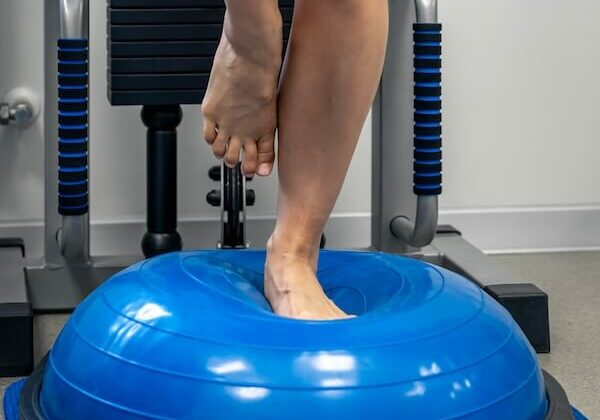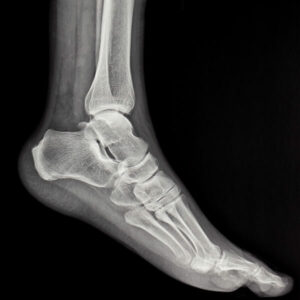Avoiding Sprained Ankle with Exercise

A sprained ankle is a common injury that can significantly impact daily activities and physical performance.
Fortunately, preventing a sprained ankle is possible through targeted exercises that strengthen the ankle joint, improve balance, and increase flexibility. This blog post aims to highlight the importance of avoiding sprained ankles with exercise, outlining specific routines and techniques that can help maintain ankle health.
FURTHER READING AND RESEARCH
Strengthening exercises are crucial in building the muscles around the ankle, providing better support and reducing the likelihood of injury.
Flexibility exercises, on the other hand, enhance the range of motion, allowing the foot to move freely without straining the ligaments. Incorporating these exercises into a regular fitness regimen can greatly reduce the risk of spraining an ankle.
This article will explore various exercises and stretches that focus on the calf muscles, balance, and ankle joint stability. It will also provide practical advice on how to integrate these exercises into an exercise program. Our goal is to empower readers with the knowledge and tools needed to avoid sprained ankles through effective and safe exercise routines.
Understanding Ankle Sprains
What is an Ankle Sprain?
An ankle sprain occurs when the ligaments that support the ankle are stretched or torn. This injury typically happens when the foot rolls inward or outward, causing the ligaments to overstretch.
Symptoms of an ankle sprain often include immediate pain, swelling, bruising, and difficulty walking or bearing weight on the affected leg. Ankle sprains can range from mild to severe, depending on the extent of the ligament damage. Prompt treatment and rehabilitation exercises are crucial for proper healing and preventing future injuries.

Common Causes of Ankle Sprains
Ankle sprains commonly occur during activities that involve sudden changes in direction, such as sports like basketball or soccer. Uneven surfaces and inadequate footwear can also increase the risk.

Walking on a flat surface can even result in a sprain if the foot lands awkwardly. Poor physical conditioning and lack of proper warm-up exercises contribute to ankle instability.
Incorporating strengthening and balance exercises into a regular fitness routine can significantly reduce the risk of sprains by enhancing the stability and resilience of the ankle joint.
Anatomy of the Ankle
The Ankle Joint and Muscles Involved
The ankle joint is a complex structure consisting of bones, ligaments, tendons, and muscles. It primarily includes the tibia, fibula, and talus bones. The tibia and fibula form the lower leg and create the ankle mortise, where the talus fits, allowing for dorsiflexion and plantarflexion movements.
Ligaments such as the anterior talofibular ligament provide stability by connecting these bones. The calf muscles, including the gastrocnemius and soleus, play a crucial role in maintaining ankle stability and preventing an ankle sprain.
These muscles control the foot's movements, particularly during activities like walking or running, and help keep the foot in a neutral position, preventing the foot from rolling inward or outward.

Supporting muscles like the peroneals and the Achilles tendon also contribute to ankle strength and stability, reducing the risk of injury. Understanding the structure and function of the ankle joint is essential for avoiding sprained ankles with exercise.
Importance of Calf Muscles in Ankle Stability
Strong calf muscles are vital for ankle stability, as they absorb shock and provide support during physical activities.

Well-developed calf muscles reduce the likelihood of ankle sprains by keeping the ankle joint stable and preventing excessive movement. Common calf exercises include calf raises, where you stand facing a table leg with feet flat and gradually lift your heels, and calf stretches to improve flexibility.
Incorporating these exercises into your exercise program can enhance ankle strength and stability, effectively avoiding an injured ankle or foot. Consistent calf muscle training is key to maintaining overall ankle health.
Effective Exercises to Prevent Ankle Sprains
Range of Motion Exercises
Range of motion exercises are crucial for maintaining and improving the flexibility of the ankle joint, which helps prevent ankle sprains. These exercises involve moving the ankle through its full range of motion to ensure that the ligaments and muscles remain supple and resilient. Examples of effective range of motion exercises include ankle circles and the ankle alphabet.
To perform ankle circles, sit in a chair with your legs extended. Slowly bring your affected leg's foot into the air and make circular motions with your ankle, first clockwise, then counterclockwise. The ankle alphabet involves "writing" each letter of the alphabet in the air with your big toe. These exercises help enhance the flexibility and mobility of the ankle joint by stretching the calf muscles and tendons. Incorporating these exercises into your exercise program can significantly reduce the risk of an injured ankle or foot during physical activities.
Strengthening Exercises
Strengthening exercises are vital for building the muscles around the ankle, providing support and reducing the risk of ankle sprains. Calf raises are an effective exercise that targets the calf muscles and improves ankle stability. Stand facing a table leg with feet shoulder width apart and gradually lift your heels off the ground, then slowly lower them back down. This exercise strengthens the calf muscle and enhances balance.
Resistance band exercises are also beneficial. For ankle dorsiflexion, sit in a chair with a resistance band looped around your foot and anchored to a sturdy object. Pull the foot upward against the band's resistance, engaging the muscles around the ankle joint. This exercise improves the strength and flexibility of the lower leg muscles.
Ankle dorsiflexion exercises, such as using an exercise band to provide resistance while lifting the foot, are essential for strengthening the front of the lower leg. Additionally, incorporating calf stretches into your routine can maintain muscle elasticity and prevent stiffness.
These strengthening exercises help fortify the ankle joint, reducing the likelihood of an injured ankle or leg. They also enhance overall ankle strength, which is crucial for avoiding sprained ankles during physical activities. Consistently practicing these exercises under a physical therapist's guidance can make a significant difference.
Balance and Stability Exercises
Improving balance and stability is key to preventing ankle sprains. Balance exercises such as single leg balance and standing on one leg can significantly enhance ankle stability. To perform the single leg balance exercise, stand on one leg with your feet flat on a flat surface and hold the position for a few seconds. Gradually increase the duration as your balance improves. This exercise helps strengthen the muscles around the ankle joint and improves proprioception.
Another effective exercise is standing on one leg while performing daily activities, like brushing your teeth. This can help integrate balance training into your routine. For an advanced version, try standing on a balance board or foam pad. These surfaces provide an unstable base, challenging your balance and strengthening the stabilizing muscles in the ankle and lower leg.
Incorporating exercises like the ankle alphabet and ankle circles can further improve flexibility and stability. These exercises enhance the range of motion and ensure the muscles and tendons are adequately conditioned to support the ankle joint.
Regularly practicing these balance and stability exercises can significantly reduce the risk of an ankle injury, such as a sprained ankle, by ensuring the ankle muscles and tendons are strong and responsive. Consult a physical therapist for a personalized exercise program that suits your needs.
Specific Exercise Programs
Creating an Exercise Program
Creating a balanced exercise program to avoid ankle sprains involves incorporating a mix of range of motion exercises, strengthening exercises, and balance exercises. Begin with a warm-up, such as a light jog or brisk walk, to get the blood flowing and prepare the muscles for activity. Include range of motion exercises like ankle circles and the ankle alphabet to enhance flexibility. Strengthening exercises, such as calf raises and resistance band ankle dorsiflexion, should also be a core part of the program. Balance exercises like single leg balance and standing on one leg will improve stability.
Consistency is key; perform these exercises regularly to see the best results. Start with low intensity and gradually increase the difficulty as your ankle strength and balance improve. Remember to listen to your body and avoid pushing through increased pain. Incorporating these exercises into your routine can significantly reduce the risk of an injured foot or leg.
Rehabilitation Exercises for an Injured Ankle
Rehabilitation exercises are crucial for someone recovering from an ankle injury. Begin with gentle range of motion exercises, such as ankle circles and ankle dorsiflexion, to restore flexibility. These can be done by sitting in a chair and moving the foot in circles or pulling the foot upward against a resistance band. Progress to strengthening exercises like calf raises and using a resistance band to perform ankle dorsiflexion. It's important to keep the knees straight and control the movement to avoid additional strain on the injured ankle.
Balance exercises, such as standing on the good foot while lifting the affected leg, can help regain stability. Gradually, increase the intensity by standing on a balance board or foam pad. Use a rolled towel under the foot to improve proprioception and control.
Follow your physical therapist's advice closely, as they can provide a tailored exercise program suited to your specific injury and recovery stage. They will also monitor your progress and adjust the intensity of the exercises as needed. It's crucial to increase the exercise intensity gradually to avoid setbacks and ensure proper healing. Consistent rehabilitation exercises can help you regain full functionality and prevent future injuries.
The Role of Physical Therapy
Physical therapy plays a vital role in recovering from an ankle injury and preventing future injuries. A physical therapist can develop a personalized exercise program that addresses your specific needs, ensuring a safe and effective recovery. They guide you through proper techniques and monitor your progress, making adjustments as needed. Physical therapy can improve ankle strength, flexibility, and balance, reducing the risk of re-injury. By following a physical therapist's advice and incorporating their recommended exercises, you can enhance your ankle's resilience and overall functionality.
Tips for Safe Exercise
Avoiding Common Exercise Mistakes
To avoid common exercise mistakes that can lead to an injured foot or ankle, it's crucial to focus on proper technique and warm-up. Always start your exercise routine with a thorough warm-up to prepare your muscles and joints for activity. This can include dynamic stretches and light cardio, such as walking or jogging. When performing ankle exercises, ensure that your feet are flat on a stable surface and your knees remain straight to avoid unnecessary strain.
Common mistakes include overloading the ankle with too much weight or not using proper form during exercises like calf raises and resistance band workouts. Using incorrect form can lead to an injured leg or back leg strain. Pay attention to your body's signals and stop if you experience increased pain. Gradually increase the intensity of your exercises to avoid overuse injuries. By following these guidelines, you can safely incorporate ankle exercises into your routine and prevent ankle sprains.
When to Seek Professional Personal Trainer
Knowing when to seek professional help is crucial for safe exercise. If you experience persistent pain, have a history of ankle injuries, or feel uncertain about your exercise techniques, it may be time to consult a personal trainer. A qualified injury rehabilitation personal trainer, like those at the Physical Training Company in Dubai, can provide expert guidance and ensure you perform exercises correctly to avoid further injury. Ignoring increased pain or continuing with improper form can lead to more severe issues. Seeking professional advice can help tailor your exercise program to your needs and promote a safe and effective recovery.
Practical Advice for Daily Life
Incorporating Exercises into Daily Routine
Incorporating ankle exercises into your daily routine can help prevent injuries and improve overall ankle health. Simple practices, such as standing on one leg while brushing your teeth or doing the dishes, can enhance balance and stability. Ensure your feet are flat and shoulder width apart for optimal support.
While sitting at your desk, try ankle circles or ankle alphabet exercises to maintain flexibility. During breaks, perform calf stretches by placing your back heel on the floor and leaning forward. Walking on a flat surface or up stairs can also strengthen your calf muscles and improve ankle dorsiflexion.
You can also use a resistance band to perform gentle strengthening exercises while watching TV. Wrap the band around a sturdy table leg, sit in a chair, and slowly bring your foot outward against the band's resistance. Integrating these simple exercises into daily activities ensures consistency and helps you avoid common ankle injuries.

